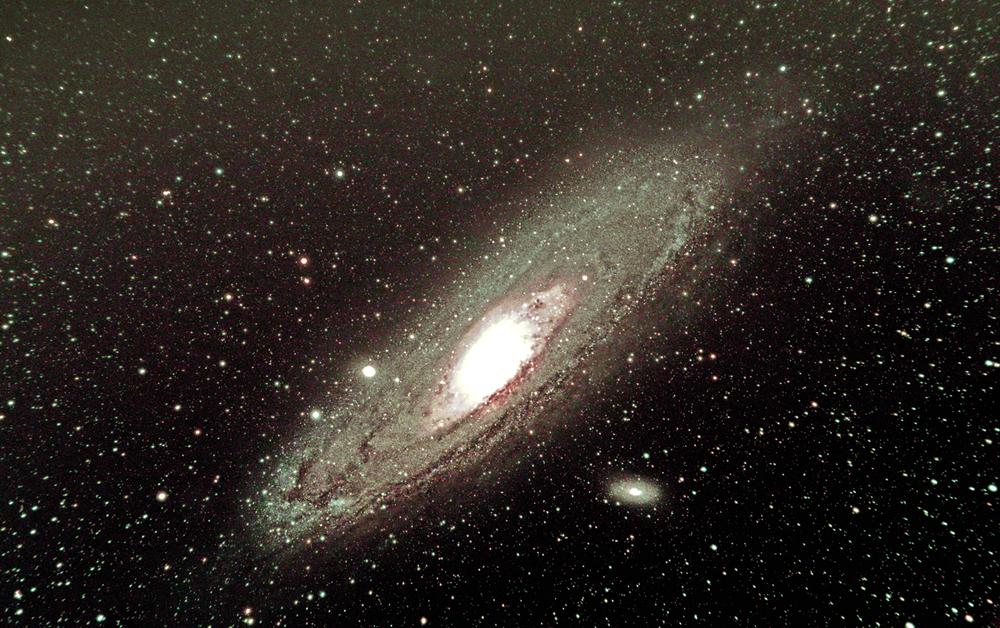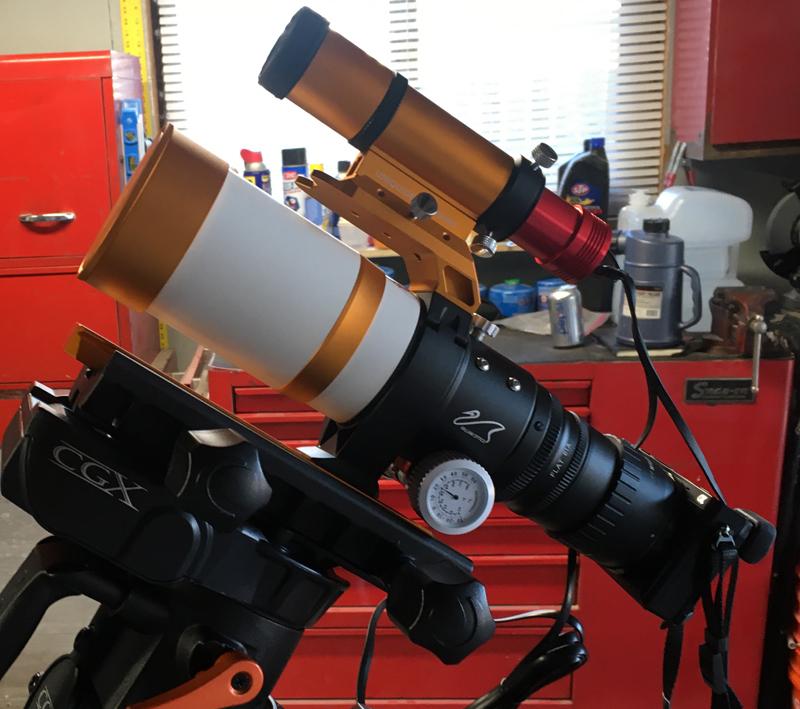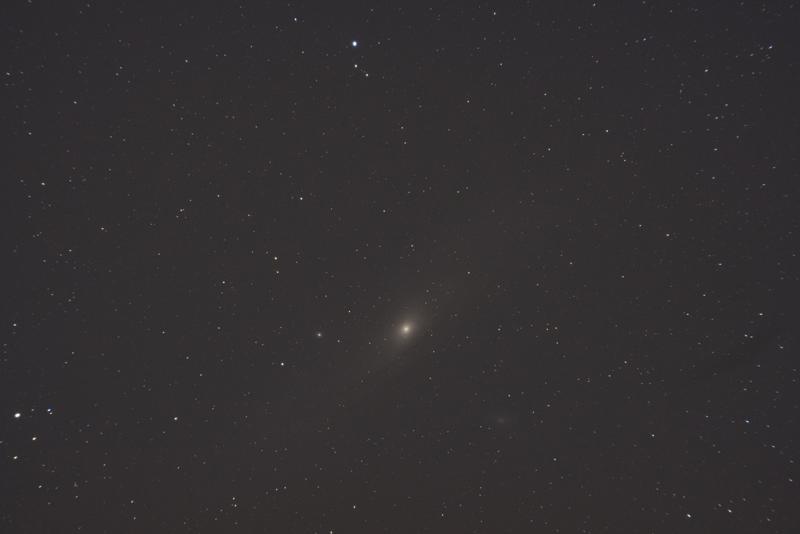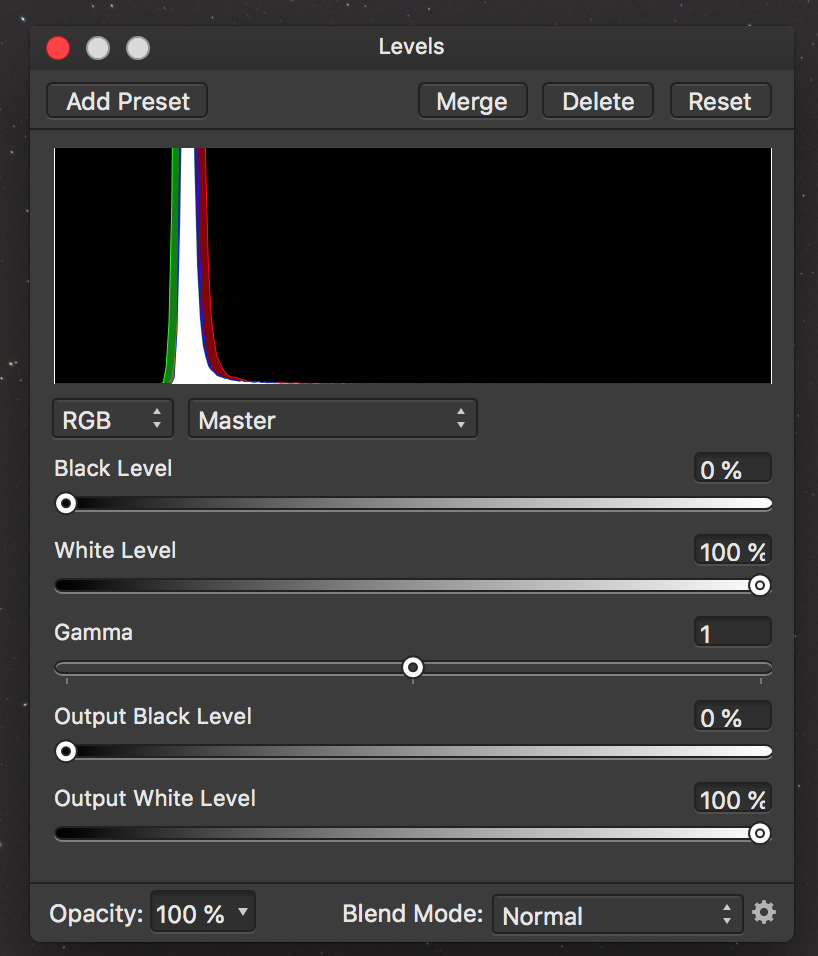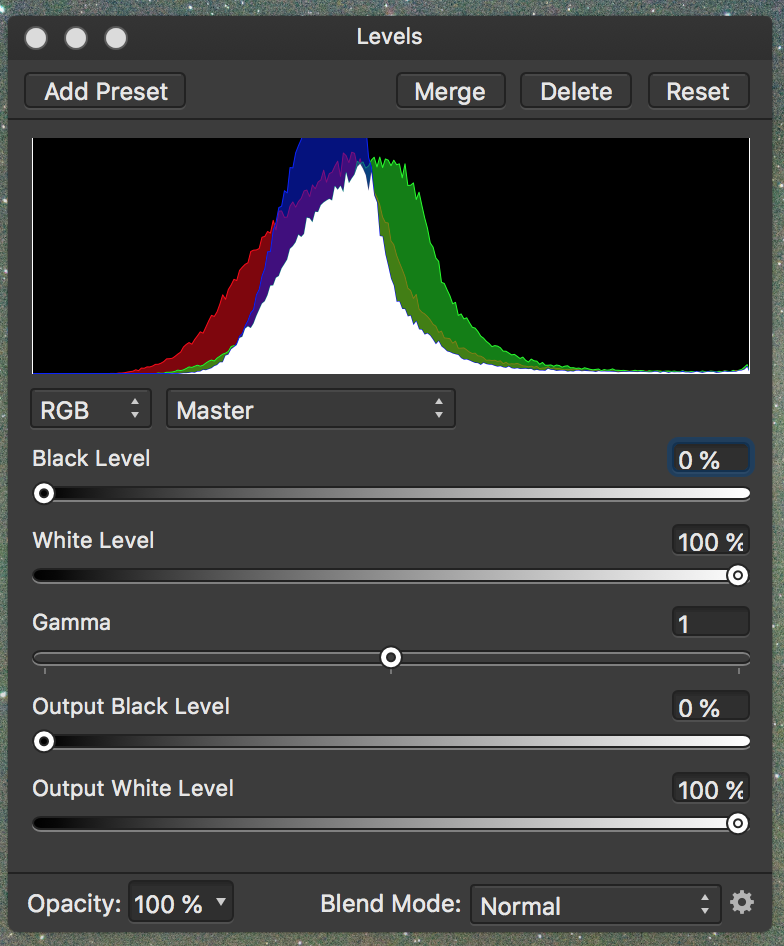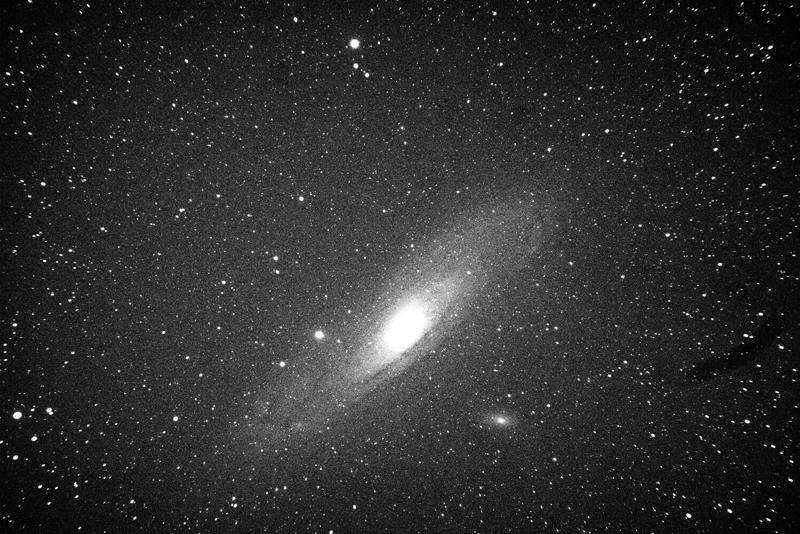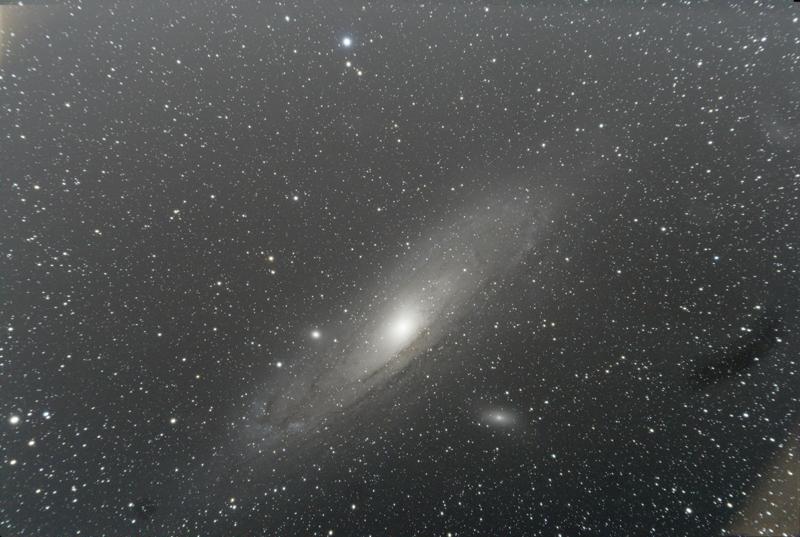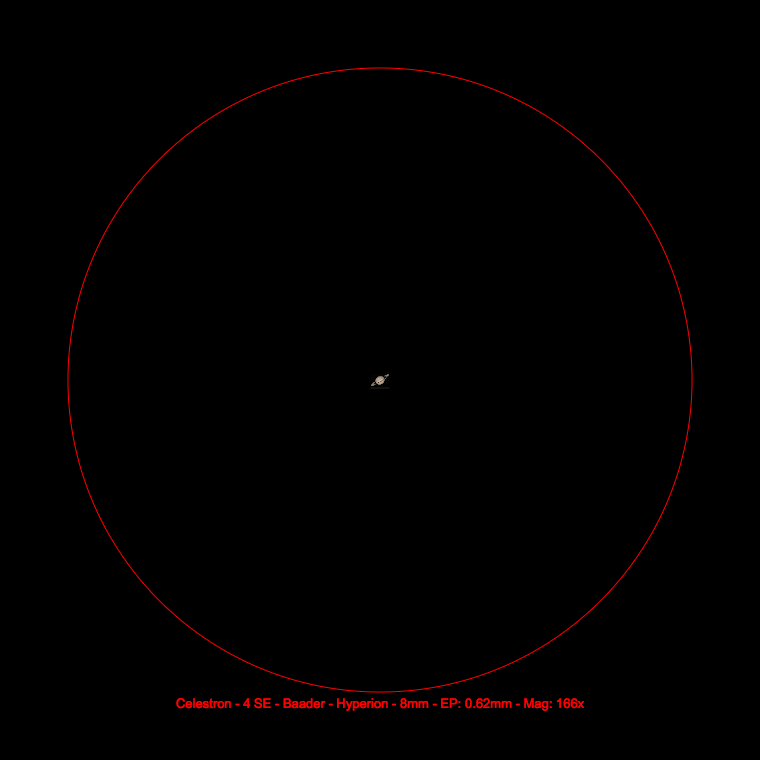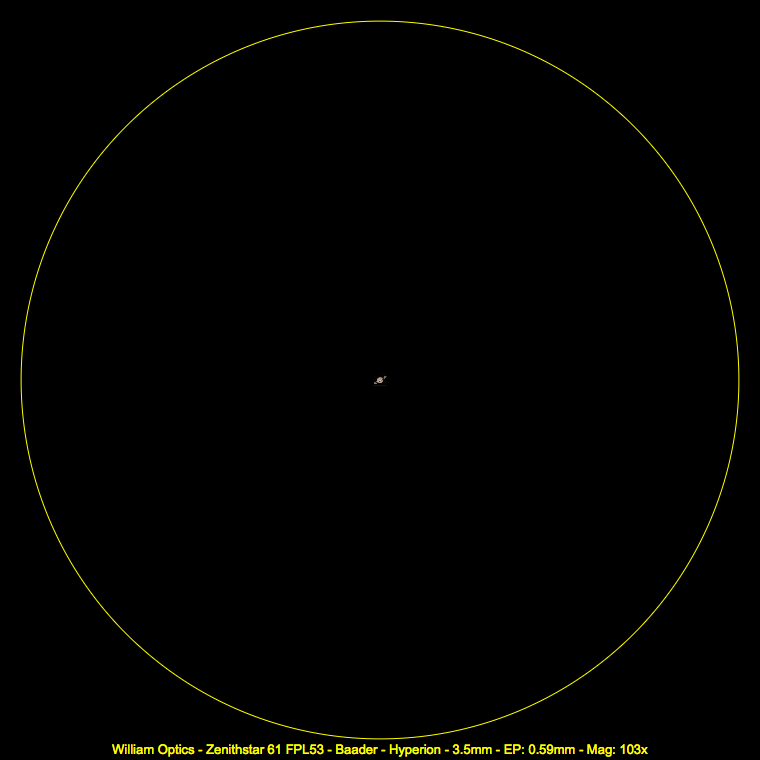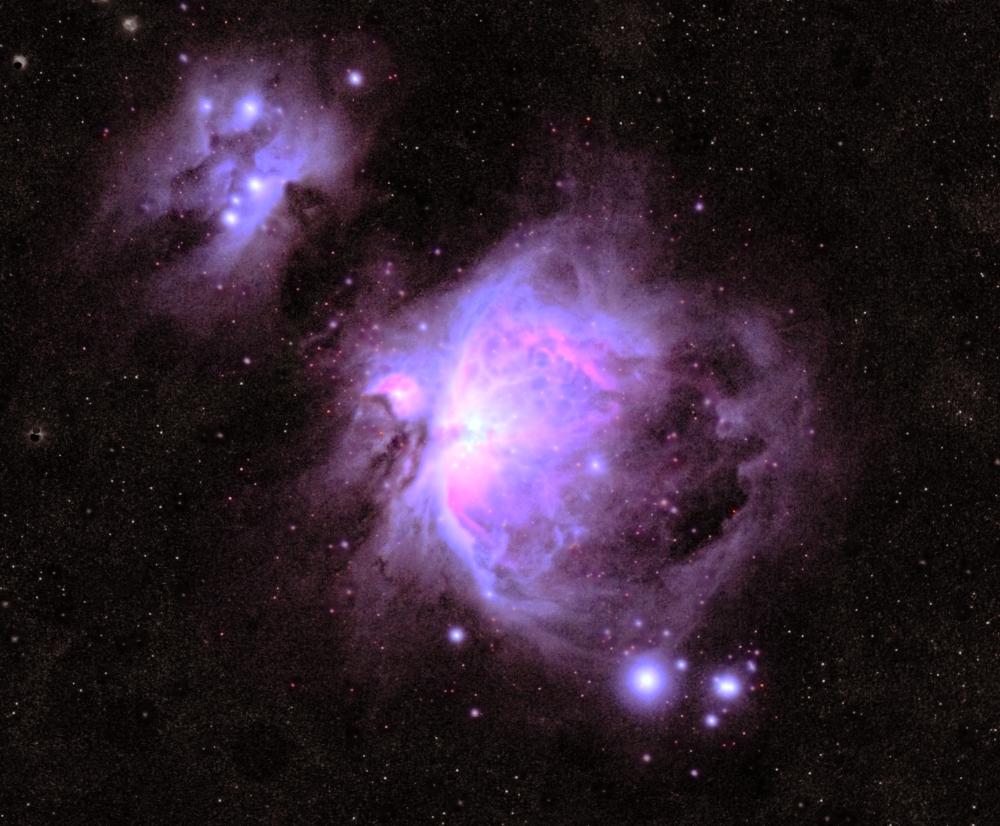Topic
Sony A6000 a Cosmic Time Machine
Forum Posting
A Membership is required to post in the forums. Login or become a member to post in the member forums!
Home › Forums › Campfire › Photo Gallery › Sony A6000 a Cosmic Time Machine
- This topic has 47 replies, 12 voices, and was last updated 3 years, 3 months ago by
 Nick Gatel.
Nick Gatel.
-
AuthorPosts
-
Nov 11, 2020 at 5:00 pm #3683496
The Andromeda Galaxy (M31) is about 2.5 million light years away. So, the image in this photo is what M31 looked like 2.5 million years ago, as my Sony camera looked into the past. Thought provoking. Does M31 still exist?
The elliptical light below M31 is the galaxy M32, and the largest bright light at the top edge of Andromeda is the galaxy M110. Both are also about 2.5 million light years away.
I figure 2.5 million light years is a good social distancing activity.
High Res version here.
 Nov 11, 2020 at 5:35 pm #3683506
Nov 11, 2020 at 5:35 pm #3683506wow, that’s amazing
with your Celestron?
Nov 11, 2020 at 5:52 pm #3683509No. I used a miniature telescope as a prime lens. It has an aperture of only 61 mm, a focal length of 360 mm (ratio is f/5.9).
The Celestron telescope is 203 mm, 2032 mm and f/10.
Nov 11, 2020 at 6:16 pm #3683511This should be the correct link for the higher resolution picture.
The colors are off, and the photo needs more post processing.
Nov 11, 2020 at 7:47 pm #3683535Pretty cool, Nick
Nov 11, 2020 at 7:53 pm #3683536Thanks guys.
M31 is the closest galaxy to our own Milky Way. It is estimated to have around 1 trillion stars in it. The immensity of deep sky objects are mind boggling to me.
Nov 11, 2020 at 8:07 pm #3683540Very cool Nick. It looks like you’re using your time wisely! :-)
Nov 11, 2020 at 8:20 pm #3683541Thanks Nick, I’ve enjoyed this. Would love to meet you in the desert for some astronomy education…
Nov 11, 2020 at 8:36 pm #3683544Craig,
I’d love to do that. Joyce still can’t walk yet, so I’m stuck at home for a while.
Cottonwood Springs Campground in JT used to be one of the best places, but JT has become overrun and overcrowded. But I have a couple other places to go now.
Nov 11, 2020 at 10:13 pm #3683560And then there a trillion (?) Galaxies.
So many there must be other earths out there with people looking at us
Nov 11, 2020 at 10:14 pm #3683561Great picture with such a small lens
Nov 12, 2020 at 3:53 am #3683582Great picture with such a small lens
Yes, it is small. My DSLR is attached to the white scope in the picture below. The A6000 is a pretty compact crop sensor body, and is physically much smaller than similar cameras.

The gold scope on the top is a guiding scope with a mini-camera instead of an eyepiece. The guide scope camera is connected to a computer that guides the telescope mount. The guide scope is focused on only one dim star and it follows the star as the earth rotates telling the computerized mount when and how much to move. It moves the mount incrementally every 2.5 seconds the way I set up the guiding software.
The photo I shared in the original post has not been enlarged!!
How can such a tiny fixed lens (no zoom) do this? Here’s the secret . . .
The Andromeda Galaxy is HUGE — only we can’t see it with our inferior eyesight.
The Moon has an apparent size of 32.9 arc-minutes.
Andromeda has an apparent size of 177.8 arc-minutes. From our view, Andromeda is 5.4 times larger than a full Moon. On a crystal clear night, if we know where it is, it is a tiny smudge in the sky to the naked eye. Below is a single 60 second exposure I took.

The picture only shows the galactic core and a tiny bit more. Because a sensor can capture much more than we can see, and because cameras are designed to replicate the human eye, we can only visually see the tiny smudge in the picture above. But all the data is stored in the picture.
Below is the RGB color histogram of the above photo. Note that all the colors are stacked into a very narrow band of space.

What we want to do is stretch this RGB data. As we stretch it, we can see more. Below is a histogram after I made 6 adjustments to the single picture above.

As the histogram is stretched, more data becomes visible. Below is the same picture after these 6 adjustments. No cropping or enlargement was done. I did turn it into a black and white version to better show what is happening, since I only spent a couple minutes doing the adjustments.

If you look at both pictures, you can see the star clusters at the top of the picture and the star cluster in the lower left are in the same position. So no “zooming” or cropping was done with the software. The second picture just shows more of the data that was captured and stored on the SD card.
Also note how many more stars are visible in the second “stretched” photo.
The Process of the photo in the original post
I took 120 pictures with an exposure of 60 seconds each, with a 61 second interval between each so the sensor could keep cool and the memory cache would clear between each exposure. I had to discard 28 photos because of satellites (Elon Musk is a villain), plus the scope tracked under a power line for a few seconds. So I ended up with 92 good photos.
Calibration photos
I also took 30 pictures with the lens cap on using the same exposure and ISO and ambient temperature.
I took 30 pictures with the cap on with an exposure of 1/4000 of a second. Then I took 30 pictures at 1/4000 of a second with the cap off, the lens covered with a white t-shirt and a white screen iPad on top of the t-shirt. These calibration photos help identify and “hot” pixels, extraneous noise or other defects.
Photo Stacking
Using special software, I stacked all 182 pictures to create a single master photo, which ended up being 320MB in size. The software took about 60 minutes to stack and integrate all 182 photos.
This is the stacked results below. Notice that there are problems in the corners, which always happens when stacking pictures (the telescope over four hours moves in an arc). Also there is a dust spot on the right side of the picture. The picture looks like it is black and white, but it is a color photo. Post processing will bring that out.
But the single stacked photo has much more data than a single exposure. This is what we want, a picture with lots and lots of data to extract for a finished product.

Post processing
This is the most important and time consuming part. I’m not completely happy with the original photo I posted. I am using a new to me program, Affinity Photo. It is very complicated and powerful, and similar to Photo Shop. Unlike my Windows version of Photo Shop CS2, that cannot handle 32 bit RGB, Affinity does handle 32 bit RGB, and my stacking program can export 32-bit RGB.
The other thing is Adobe has gotten greedy with their subscription model and pricing. I’m not going to spend that kind of money to upgrade. Affinity Photo is a direct competitor and can read PS files and also run Photo Shop plug-ins. They have versions for Mac, Windows, and Linux operating systems. I paid $49 and it is much, much more powerful and polished than I anticipated for under $50.
The internet and bookstores are full of how-to do Photo Shop information, and Affinity lacks these kinds of resources, since it has only been on the market for 3 years or so. If anyone is looking for a full featured photo processing program, take a look at Affinity Photo.
I have only had Affinity Photo for about a week, and anyone who has experience post processing using layers, curves, levels, masking, etc., knows 1 week isn’t enough time to learn a powerful program like Affinity or PS. So I am at the beginning of that learning curve. This is why my final product isn’t as good as I could do with my current version of PS. But I have to learn how to use Affinity Photo, so that is why.
Anyway, this is a long-winded post. I learned a lot about trail cameras when Katharina started her hobby, so maybe anyone who is interested in astrophotography might find this helpful. Astrophotography can be really expensive. But if you already own a DSLR and a decent lens, then a lot can be done with that. However, if you want to capture deep space objects like M31 where many exposures of 30+ seconds are required, then a computerized equatorial mount is necessary and good ones are expensive.
Nov 12, 2020 at 8:46 am #3683597I’ve always wondered what was involved in creating those images.
Thanks for a great “tour”.
Nov 12, 2020 at 8:47 am #3683600That all is really cool
It’s amazing what you can do with such basic equipment, that is, compared to astronomer’s equipment
Nov 12, 2020 at 9:09 am #3683605This is fascinating, thanks for the tutorial…
Nov 13, 2020 at 1:43 am #3683855Some additional editing since the “seeing” tonight is poor due to high clouds and light pollution.

My goal was to show the white/yellow of the core and then transition to red/brown ring. The outer edges should have a bluish tint. As the distance increases from the core the transparency should increase and more individual stars should become apparent.
Taking pictures from my light polluted backyard makes things a little difficult.
Adjustments are mostly color balancing, tonal changes, brightness and contrast, etc. I do not cut/paste, paint colors, or anything like that. Adjustments are tweaking the colors captured by the camera’s sensor.
Nov 13, 2020 at 7:58 am #3683873there’s a blob below and to the right, must be another galaxy?
there’s a blob in the middle of Andromeda, that must be a bunch of stuff at the center of Andromeda?
I wonder if astronomers use the same trick of taking multiple images and then combining. That way, they could remove any Elon satellites. I bet there would be other advantages. It would create a huge amount of data and require a huge amount of processing, but memory and computers are cheap.
Imaging masks for semiconductors uses the same trick only in reverse. Print the image 8 times. It averages out errors. If the 8 images are slightly different you can get resolution better than a pixel size. If 4 of the exposures print a square, and 4 print it 1 pixel bigger, the resultant image will be 1/2 pixel bigger.
Nov 13, 2020 at 8:50 am #3683875I might just have to purchase a telescope. I’ve started to take short solo trips to the darkest areas of MN, and like staying up late looking at the stars. This time of year I could take the telescope in my pulk and really see some cool stuff.
Nov 13, 2020 at 9:23 am #3683878Beautiful image. Lots of work but worth it!
The scale of the universe is beyond comprehension, and the visible universe is only a fraction of what is actually out there.
For us astronomer wanna-be’s SkyView is a great free app that will identify whatever stars, planets and constellations you point your phone at.
Nov 13, 2020 at 1:12 pm #3683918Jerry,
Those two are galaxies, M32 and M110. M means an object catalogued by Charles Messier in the late 1700s.
On the last image I stacked the photos with a different stacking program, Deep Sky Stacker, which is a free program and works better than the first one I did.
The program looks at each pixel in every picture (over 24 million pixels for each photo), then it matches a certain number (user selectable) of stars to calculate the offset of each one compared the others. Then the program stacks each photo by aligning the stars, not the pixels. If the exposures are too long, the program won’t be able to detect enough stars, too short of an exposure doesn’t have enough time to capture enough RGB. My camera can show the histogram of any picture I have taken. So before I start a series of timed pictures, I check the histogram of some test shots. A picture will the proper mix of exposure time and ISO will place the RGB stack in an area on the left of the graph around a 25%-30% quadrant. In really dark sky locations, longer exposures are possible because there isn’t any light pollution to deal with.
From the Deep Sky Stacker program notes:
“For each picture DeepSkyStacker will attempt to automatically detect the stars. In simple terms, DeepSkyStacker considers that a star is a round object whose luminance decreases regularly is every direction, and whose radius is no more than 50 pixels. Note that DeepSkyStacker will reject elongated star images which might occur if your mount isn’t tracking correctly. Once the star is detected its exact center is computed by fitting a Gaussian curve to the luminance.”
If you take a close look at my picture, most of the stars are nice and round meaning the focus of the scope was accurate and the stars lined up properly. If there is a problem, such as I bumped the telescope while taking a picture, the program will reject that particular image.
Nov 13, 2020 at 2:10 pm #3683926I might just have to purchase a telescope. I’ve started to take short solo trips to the darkest areas of MN, and like staying up late looking at the stars. This time of year I could take the telescope in my pulk and really see some cool stuff.
Yes, but you need to set your expectations if you haven’t owned a telescope before. Visual observations don’t reveal images like the Hubble pictures we see published :-(
There is a website that can predict what an image with a certain telescope and eyepiece will look like.
Below is what Saturn will look like with a Celestron 4se scope (4 inch aperture) with an 8 mm eyepiece.

With a 14″ aperture Celestron Schmidt Cassegrain Telescope and an 8mm eyepiece Saturn would look like this:

This picture looks great, but not many people own a 14″ scope and they are mostly for home or observatory use. The scope, mount, and tripod are going to weigh around 175 lb and cost at least $8,000 with a few eyepieces.
But as I have shown, a small refractor type scope with a DSLR can take great pictures and can be also used as a visual instrument. Plus many people already own a DSLR.
Using a 3.5 mm eyepiece with this little scope, Saturn would look like this below, which is probably the largest useful magnification for the scope. The scope weighs less than 4 lb.

With a DSLR and a simple tripod exposures will be limited to 15 seconds or less. With a tracking mount, much longer.
I have starting writing a series of very non-technical articles on my blog. This one discusses expectations and a link to a calculator to create images with different scopes.
Dec 6, 2020 at 4:01 pm #3687531Another image of the Andromeda Galaxy
 Dec 6, 2020 at 4:05 pm #3687534
Dec 6, 2020 at 4:05 pm #3687534Ms. Sony A6000 travels to Orion
Just below Orion’s belt is the Orion Nebula, which is the large object in the image below. To the upper right of this nebula is the Walking Man Nebula. Take a closer look and you will see a “stick man” in the center of this smaller nebula. Compared to the Andromeda Galaxy, which is 2.5 million light years from our home planet, the Orion Nebula is only 1,344 light years from earth.
 Dec 6, 2020 at 5:48 pm #3687554
Dec 6, 2020 at 5:48 pm #3687554Great stuff Nick; thanks for the pics and the tutorial.
Dec 6, 2020 at 8:18 pm #3687588Opps. Walking man is at the upper LEFT.
Thanks jscott.
-
AuthorPosts
- You must be logged in to reply to this topic.
Forum Posting
A Membership is required to post in the forums. Login or become a member to post in the member forums!
Our Community Posts are Moderated
Backpacking Light community posts are moderated and here to foster helpful and positive discussions about lightweight backpacking. Please be mindful of our values and boundaries and review our Community Guidelines prior to posting.
Get the Newsletter
Gear Research & Discovery Tools
- Browse our curated Gear Shop
- See the latest Gear Deals and Sales
- Our Recommendations
- Search for Gear on Sale with the Gear Finder
- Used Gear Swap
- Member Gear Reviews and BPL Gear Review Articles
- Browse by Gear Type or Brand.

